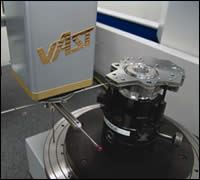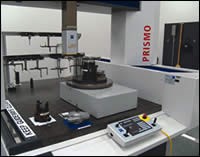CAD/CMM Combo Alleviates Programming Bottleneck
For the Common Rail Division at Robert Bosch Corporation, consistent output of accurate data is essential for ensuring uninterrupted manufacturing processes and producing quality products.
Share




Running five shifts, supporting four different product lines and processing more than 20,000 parts per month requires not only detailed planning, but also reliable inspection technology. For Dietmar Ingensiep, Group Leader of the Common Rail Division at Robert Bosch Corporation (Charleston, South Carolina), consistent output of accurate data is essential for ensuring uninterrupted manufacturing processes and producing quality products.
When Mr. Ingensiep assumed leadership over the department, he noticed the extensive time needed to develop new coordinate measuring machine (CMM) programs, which represented a major bottleneck. Four years later, with the help of dependable CMM technology and software, this bottleneck is no longer a concern.
Part of the Bosch Group automotive technology business, Robert Bosch Corporation manufactures OEM components for customers such as Ford, GM and DaimlerChrysler. These components include anti-lock brake systems as well as fuel injection and diesel injection systems such as common rail and unit injectors. At its Charleston, South Carolina plant, eight CMMs from Carl Zeiss, IMT Corporation (Maple Grove, Minnesota) work nonstop to keep the production running.
In 1989, the company purchased a UC 550 and an Eclipse CMM to support ABS production. Over the years, as more product lines were added, Bosch also increased its inspection capacity by adding two Contura and four Prismo CMMs, both of which are equipped with VAST sensor technology and Calypso CAD-based software. VAST sensor technology allows high speed, multi-point measurement of size, form and position—an important factor when inspecting a range of parts. The manufacturer cites key benefits of Calypso as its off-line programming capability and simplified creation of measuring programs.
Each month, between 7,000 and 9,000 jobs are processed in two metrology labs. With a standard job consisting of three components, the company inspects anywhere from 21,000 to 27,000 parts. That kind of volume requires not only quick turnaround time, but also machine reliability.
“The CMMs are essential to our success,” Mr. Ingensiep says. “Certain production areas rely on CMM data to adjust their machines. If the data is incorrect, then it would not be noticed until the part hits the assembly line, which would be too late and could cause production to shut down.”
Although Bosch is dedicated to meeting customer requirements, the company realizes that when dealing with metrology, the customer is not the driving force.
“There is nobody that has more influence than our internal customers,” says Mr. Ingensiep. “We are constantly challenged, for example, by our product development department. It is not only the accuracy, but it is also the fact that the parts are getting smaller and smaller. We are always pushing the envelope in all aspects of product design, and therefore pushing the capabilities of each of the CMMs. Our customers expect a product that works flawlessly. It is our job to design, measure and produce it.”
For Bosch, this also implies investing in the latest technologies. With several product lines manufacturing the same products at different locations worldwide, consistently making quality parts at each location is a priority. This means that the same measuring equipment and production machines are purchased for each facility.
Before installing Calypso CAD-based software, Bosch’s in-house programming resources were limited because of the lengthy process of learning the programming language. The company largely depended on external companies to write programs. Often, several iterations were necessary before programs were ready. This time-consuming process also resulted in high costs driven by an ever-changing environment requiring frequent program modifications.
Using the new software, the company can now write programs off-line, while the CMMs continue to measure production parts. The company remarks that the short learning curve of the software also allowed it to train several of its quality personnel within a couple of months. By increasing the company’s on-site knowledge pool, Bosch can now implement software program modifications immediately, making parts inspection a more efficient process.
Read Next
5 Rules of Thumb for Buying CNC Machine Tools
Use these tips to carefully plan your machine tool purchases and to avoid regretting your decision later.
Read MoreSetting Up the Building Blocks for a Digital Factory
Woodward Inc. spent over a year developing an API to connect machines to its digital factory. Caron Engineering’s MiConnect has cut most of this process while also granting the shop greater access to machine information.
Read MoreBuilding Out a Foundation for Student Machinists
Autodesk and Haas have teamed up to produce an introductory course for students that covers the basics of CAD, CAM and CNC while providing them with a portfolio part.
Read More



























.jpg;maxWidth=300;quality=90)




